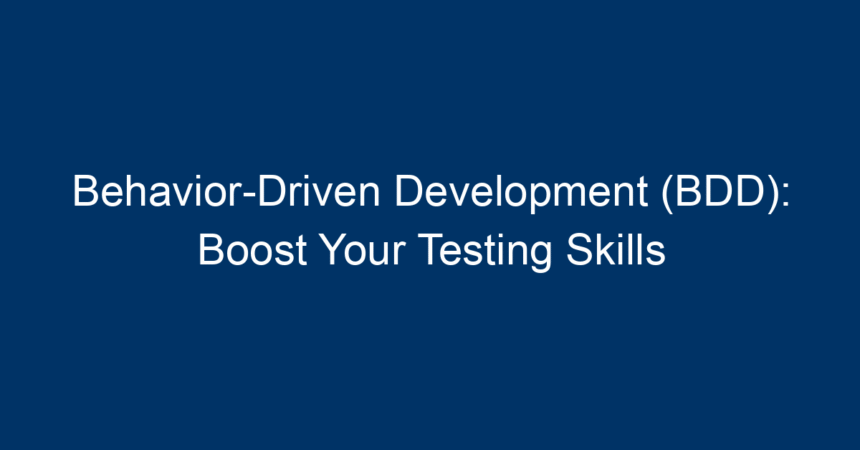In the world of software development, ensuring that your application performs as expected is crucial. This is where the concept of Behavior-Driven Development (BDD) shines. BDD takes software testing beyond mere technical verification, emphasizing collaboration among developers, testers, and stakeholders. This method not only enhances the quality of software but also boosts team productivity. In this article, we’ll explore what BDD is, its benefits, best practices, and practical tips to improve your testing skills using this powerful approach.
Understanding Behavior-Driven Development (BDD)
What is BDD?
Behavior-Driven Development (BDD) is a software development approach that encourages collaboration between developers, testers, and business stakeholders. BDD focuses on defining the behavior of an application from the end user’s perspective, ensuring that the software meets real-world needs. By using a common language known as “Gherkin,” team members can write test cases that are easily understood by everyone involved.
The Key Concepts of BDD
-
User Stories: BDD starts with the creation of user stories, which describe the functionality from the end user’s viewpoint.
-
Acceptance Criteria: Each user story is paired with acceptance criteria, which outline the conditions that must be met for the story to be considered complete.
- Gherkin Language: Test cases are written in Gherkin syntax, employing keywords like “Given,” “When,” and “Then,” making the tests more readable and understandable.
The Benefits of BDD
Adopting Behavior-Driven Development (BDD) can significantly enhance the software development process. Here are some compelling benefits:
1. Improved Collaboration
BDD promotes a culture of collaboration among all stakeholders. Developers, testers, and business analysts work together to clarify requirements and expectations. This joint effort leads to fewer misunderstandings and results in software that aligns more closely with business needs.
2. Enhanced Test Coverage
BDD emphasizes the importance of defining testing scenarios upfront. This approach helps ensure comprehensive test coverage, as the entire team collaborates to identify edge cases and potential failures before the coding begins.
3. Clearer Communication
The Gherkin language used in BDD enhances communication among team members. Since the test scenarios are written in plain language, everyone, regardless of technical expertise, can understand the test cases and contribute to discussions about functionality.
4. Faster Feedback Loops
With a strong focus on automated testing, BDD enables quicker feedback loops. Teams can run automated tests to validate changes frequently, allowing for quicker detection and resolution of issues, which speeds up the overall development cycle.
5. Improved Quality of Software
Because BDD helps define expectations clearly and ensures that all scenarios are covered, the likelihood of defects decreases. This leads to higher-quality software that meets user satisfaction.
Implementing BDD in Your Workflow
Step 1: Define User Stories
The first step in implementing Behavior-Driven Development (BDD) is creating user stories. These should be written from the user’s perspective to ensure they capture true business needs. A well-structured user story typically follows this template:
As a [role], I want [feature] so that [benefit].
For example, “As a shopper, I want to add items to my cart so that I can purchase them quickly.”
Step 2: Establish Acceptance Criteria
Once user stories are defined, the next step is to establish clear acceptance criteria. These criteria will serve as the foundation for your BDD tests. Use the Given-When-Then format for clarity:
- Given: establishes the initial context or state.
- When: describes the action taken by the user.
- Then: specifies the expected outcome.
For example:
- Given I have items in my cart,
- When I proceed to checkout,
- Then I should see a summary of my order.
Step 3: Write BDD Scenarios
With user stories and acceptance criteria in place, you can begin writing scenarios using the Gherkin syntax. Each scenario should capture a specific aspect of the user story, making it easy to automate later.
gherkin
Feature: Shopping Cart
Scenario: Successful checkout
Given I have items in my cart
When I proceed to checkout
Then I should see a summary of my order
Step 4: Automate Tests
The next step in Behavior-Driven Development (BDD) is to automate your test scenarios. Various tools such as Cucumber, SpecFlow, and Behave can be used to convert your Gherkin scenarios into executable tests.
Step 5: Continuous Feedback and Iteration
BDD is not a one-time process; it requires ongoing collaboration and iteration. Regular code reviews, feedback sessions, and revisions based on stakeholder input can help refine user stories and acceptance criteria, further enhancing your testing skills.
Best Practices for Successful BDD Implementation
-
Involve All Stakeholders: Ensure that developers, testers, and business analysts participate in the BDD process from the beginning.
-
Keep Scenarios Simple: Each scenario should focus on a single feature or behavior, making it easier to understand and maintain.
-
Regularly Review and Update: As business needs evolve, so should your user stories and acceptance criteria. Regular reviews can help keep everything aligned.
-
Focus on Business Value: Ensure that all features developed provide tangible business value to prioritize development efforts effectively.
- Encourage a Culture of Testing: Foster an environment where testing is valued as an integral part of the development process.
Common Challenges in BDD
Despite its numerous benefits, implementing Behavior-Driven Development (BDD) comes with challenges:
-
Resistance to Change: Team members may be resistant to adopting new practices. Providing training and demonstrating the value of BDD can help mitigate this.
-
Difficulty in Writing Clear Scenarios: It can be challenging to write scenarios that are both simple and comprehensive. Encouraging collaboration can alleviate this issue.
- Tooling Issues: Selecting the right automation tools can be daunting due to the variety of options available. Thorough research and consideration of team skill sets can lead to better decisions.
Conclusion: Take Action with BDD
Incorporating Behavior-Driven Development (BDD) into your software testing strategy can significantly improve communication, collaboration, and quality. By focusing on the end-user perspective, you can create software that truly meets user needs while enhancing your team’s workflow. Start by defining user stories, establishing clear acceptance criteria, and automating your tests to reap the benefits of BDD.
By embracing this methodology, you not only heighten your testing skills but also contribute to the delivery of high-quality software that drives business success. Begin your journey into Behavior-Driven Development (BDD) today and watch your testing skills soar!




